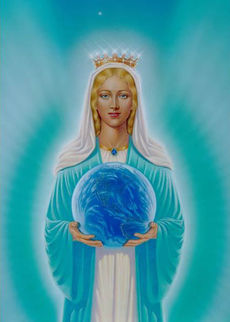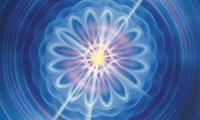Hail Mary
A salutation meaning “Hail, Mother ray”; an affirmation of praise to the Mother flame in every part of life.


the Spoken Word</translate>
Each time we say the Hail Mary we are giving the salutation to the Mother ray within our own being, to the energy—the pure white light of God—that is focused in the base-of-the-spine chakra.
When we say, “Hail, Mother ray,” it activates that forcefield, and by and by, increment by increment it slowly rises, naturally and in consonance with the laws of God, without being forced and without endangering the soul’s evolution.
Origins of the prayer
The first part of the Hail Mary is the angelic salutation of Gabriel, “Hail, Mary, full of grace, the Lord is with thee.” (Luke 1:28) To this was added Elisabeth’s salutation to Mary, “Blessed art thou among women, and blessed is the fruit of thy womb.” (Luke 1:42)
The third part of the Hail Mary was inspired by the Council at Ephesus in A.D. 470. The prayer “Holy Mary, Mother of God, pray for us sinners, now and at the hour of our death” settled the Nestorian heresy which arose from the mouth of Anastasius, “Let no one call Mary the mother of God, for Mary was a human being; and that God should be born of a human being is impossible.”[1] With this additional affirmation, the Council at Ephesus affirmed the Motherhood of God for all of Christendom.
The meaning of “Mother of God”
Mother Mary explained her calling as the Mother of God:
- I AM a cosmic mother, and as much your mother as I am the mother of beloved Jesus. Some who are adherents of the Christian faith call me the Mother of God. To those of the protesting branch of orthodox Christianity this seems a sacrilege; for men may well ask, “Who is worthy to be the Mother of God?”
- But this concept, when understood to mean the mother of the embodiment of the Divine Spirit, reveals the glorious truth that every mother who understands that which was spoken—“and the Word was made flesh and dwelt among us”[2]—may be the Mother of God.[3]
To mother means to give birth to, to give rise to, to care for, and to protect. Therefore, to be the mother of God is to give birth to, to give rise to, to care for, and to protect His Flame on earth. To mother the Flame of Spirit in the plane of Matter is the calling of the Feminine Ray in both man and woman.
Affirming our victory rather than our death
The third part of the Hail Mary succeeded in affirming the Motherhood of God; however, it also assigned to man the role of sinner and emphasized death as the end of the life of the sinner. Mother Mary has said that Keepers of the Flame ought not to affirm their sinful nature, but rather their rightful inheritance as sons and daughters of God; nor should they dwell upon the hour of death, but rather upon the hour of victory.
The Mother of Jesus therefore asked that we pray for her intercession “now and at the hour of our victory over sin, disease, and death,” thereby drawing their attention to the hour of victory over all conditions of time and space which her blessed Son proved in his life and in the hour of his victorious ascension. She affirmed the “hour of our victory” to be the eleventh hour when the greatest vigilance is required to countermand the backlash of the tail of the dragon depicted by Saint John the Revelator as being wroth with the Woman and going forth to make war with the remnant of Her Seed.
She promised to assist Keepers of the Flame, disciples of Christ, and devotees of the Mother Flame in winning their victory and the victory for all mankind if they would thus pray to her:
- Hail, Mary, full of grace.
- The Lord is with thee.
- Blessed art thou among women
- and blessed is the fruit of thy womb, Jesus.
- Holy Mary, Mother of God,
- pray for us, sons and daughters of God,
- now and at the hour of our victory
- over sin, disease, and death.
See also
For more information
Elizabeth Clare Prophet, Mary’s Message for a New Day.
Sources
Elizabeth Clare Prophet, Inner Perspectives, chapters 50 and 55.
Elizabeth Clare Prophet, Mary’s Message for a New Day, part 2, “Christian Prayer Forms and the Evolution of the Rosary.”
